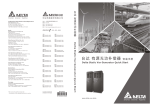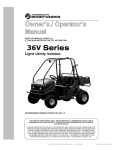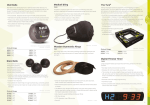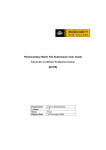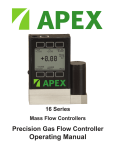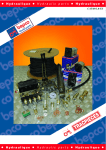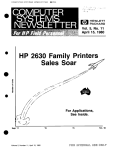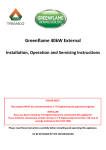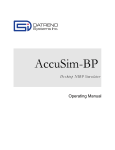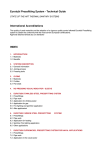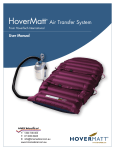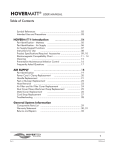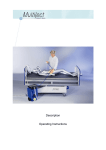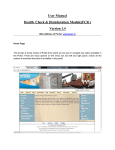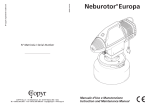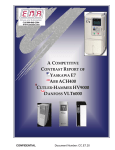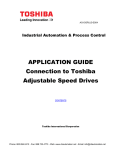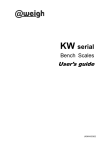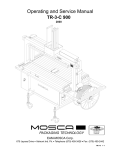Download APF2000
Transcript
2013-03-01 5012624200-APQ0 Before You Start Please carefully read and be aware of the relevant safety information before operating this product for your and the product's safety. ; Please make sure that the power is off before configuring wires or installing the Active Power DANGER Filter (APF). ; Wait at least 10 minutes after turning off the AC power, as high voltage still exists inside the Active Power Filter (APF) and is extremely dangerous. Please make sure that the DC voltage drops to 0V before configuring wires or installation. ; The IC components on the Active Power Filter's internal circuit board are susceptible to damage from electrostatic discharge, please do not touch the circuit board with bare hands. Unauthorized alteration of components or circuits within the Active Power Filter (APF) should be avoided. ; The Active Power Filter (APF) and its components should not be installed near heat sources and flammable objects. ; If working under humid or live wire conditions is unavoidable, please stand on dry rubber mats or wooden boards and wear insulated gloves. ; All models come packaged with a user manual and 2 keys. Please keep them safe as we are CAU TION unable to provide replacements if the keys are lost or stolen. If you need help unlocking the device, please ask for assistance at a local dealer, or contact Delta's Industrial Automation Business Unit. ; Read and follow all instructions in this user manual before installing, operating, or servicing the product. Please keep the user manual, do not discard as it will be needed for further use. ; Before installation or maintenance, wear appropriate safety clothing, follow safety operating procedures, and use proper testing equipment as electric spark may damage the eyes, burn skin, damage equipment, or ignite combustibles. ; Only specialists from the manufacturer or authorized dealers may perform maintenance on the Active Power Filter (APF). Installation, wiring, and maintenance of the Active Power Filter (APF) may only be performed after the content of this manual is clearly understood. ; Have certified electrical professionals confirm that the Active Power Filter (APF) has been properly grounded to prevent injuries caused by leakage current. ; Even if the Active Power Filter (APF) is powered off the main circuit terminals inside the Active Power Filter (APF) may still carry dangerously high voltage. ; If unpacked and used for over 3 months, the ambient temperature of the storage environment must not exceed 30°C as the capabilities of the electrolytic capacitors deteriorate easily when stored at a high ambient temperature without power. Please do not leave the device powered off for a period longer than 1 year. ; Notes for the disinfection and disinfestation of packaging materials for transportation and installation (including wooden crates, planks, cardboard boxes, etc.): 1. When disinfecting or disinfesting packaging materials, such as crates or cartons, please I do not fumigate to avoid damaging internal components. 2. Please use alternative environmental disinfection or disinfestation methods. 3. High-temperature usage: The packaging materials can be left at a temperature over 56°C for approximately 30 minutes or more. 4. Fumigation should be avoided. Any damage caused by fumigation will not be covered by the warranty. NOTE The pictures and corresponding descriptions in this manual will feature the product with the outer casing or safety shields removed or disassembled to better explain the product in detail. As for the actual product in operation, please be sure to correctly install the outer casing and wirings in accordance with the rules and regulations, and operate the product following the instructions in the manual to ensure your safety. The illustrations in the manual may slightly differ from the actual product for demonstration purposes, but will not affect the rights and interests of the customer. When product documentation is updated or modified, the latest edition can be downloaded from the industrial automation product page on the Delta Electronics website. ( http://www.delta.com.tw/industrialautomation/ ) II Installation checklist Verify the mechanical and electrical installation of the machine before start-up. Go through the checklist below together with another person. NOTE Only qualified electricians are allowed to commission the device. Read and follow the safety instructions on the first pages of this manual. Neglecting the safety instructions can cause injury or death. Set up □ Is the APF stored in an indoor and well ventilated area with a relative humidity of <90% and without frost? □ Is the operating temperature around APF kept between -10~45°C? □ Is the APF installed in places that meet the following contamination level: Level 2 (suitable for factory environments) and air without contaminated substances or e-waste contaminated dust particles? □ Is the storage location qualified for fire safety, dust-free, without crossive gases in the surrounding area? □ Is there any heavy object stack on top of the APF? □ Is APF placed on a flat ground/surface? □ If there is too much dust at the operating environment, is an APF equipped with air filter chosen? Electrical Installation □ Is the equipment’s grounding properly made? □ Is the APF’s input voltage the same as the power supply’s voltage? □ Is the wiring of input terminal properly distributed? □ Are the power cables correctly chosen? (Refer to the user manual for details.) □ Is the input side connect to a fuse and switch connector? (Refer to user manual.) □ Is the voltage of the power transformer the same as the voltage of power supply? □ Is the direction to install CT correct? (Connect the electric gird side to K (S1), connect the loading side to L (S2)) □ Are the diameter and the length of power cables to install CT correct? (See user manual) □ Are there any conductors or extra accessories in the APF? □ Is the separator put back to its original place after the transformer’s voltage is adjusted? Before turning on the power □ Is the input side/output sides of the power protection are uncharged before power on the APF? □ Is the cabinet door properly closed after the wiring? □ Is the warning sign “Do NOT touch the power cable!” available to warn users after the wiring of power cables is done? □ Is the warning sign “Do NOT touch the power cable!” obvious enough for users to see when power cables are outside of the cabinet? Turn on the power □ Is the line-circuit breaker of the main power transformer turned on? □ Are the breakers of APF, switch connector and transformer turned on? □ Does the fan function properly after the power on? □ Is the air outlet blocked after the power on? □ Does the power management system function properly after the power on? □ Does the touch panel of the power management system function properly after power on? III Table of Contents 01 Product Overview……………………………………………………….………………………...1-1 1-1 Usage….………………………………………………………………………..…….…………………1-1 1-2 Storage…….……………………………………………………………………….……………………1-1 1-3 Transportation…….……………………………………………………………….……………………1-2 02 Product Installation…………………………………………………………………..….……..…2-1 2-1 Installation………………………………………………………………………….……………………2-1 2-1-1 Installation Precautions………………………………………………………………….….……2-1 2-1-2 Description of Appearance ……………………………………………………………….…..…2-2 2-2 Internal Introduction……………………………………………………………….……………..…….2-4 2-2-1 Description of Nameplate ……………………………………………………………………..…2-4 2-2-2 Part Locations…………………………………………………………………………………..…2-4 2-3 Cabinet Installation………………………………………………………………………………….…2-6 2-4 W iring Installation……………………………………………………………………………………2-11 2-4- 1 W iring………………………………………………………………………………………….…2- 15 2-5 Exterior Dimensions………………………………………………………………………….………2-16 03 Specifications………………………………...………………….…….………………………….3-1 3-1 Specifications Table……………………………………………………………………………………3-1 3-2 Optional Accessories…………………………………………………………….………………….…3-1 3-2-1 Current Transformer………………………………………………………….…………...…...…3-1 3-3 Control Terminal Descriptions………………………………………………………….….…........…3-1 3-4 Lightning Protection Module……………………………………………………….…………….....…3-1 3-5 Fans…………………………………………………………………………….……………..……...…3-1 3-6 Transformer………………………………………………………………….……………..….........…3-1 3-7 AC/DC Power Source………………………………………………………………….…….….….…3-1 04 Power Quality Management System …...………………………………………..…...……….4-1 05 Maintenance…………………………………………………………………………….……….…5-1 IV Product Overview 01 Product Overview 1-1 Usage The Active Power Filter is used for the compensation of harmonics, but the amount of harmonics and the capacity of the Active Power Filter must be considered to avoid insufficient capacity affecting the compensation results. An external harmonic current detection CT needs to be installed for the Active Power Filter to perform harmonic treatment. To ensure the Active Power Filter performs with maximum efficiency, please install the device in a well ventilated environment and do not block or cover the air vents. Refer to Figure 2-1a / 2-1b. Please keep the ambient operating temperature around the Active Power Filter at -10~45°C. Exceeding this temperature range will lead to abnormal behavior of the Active Power Filter. Upon receiving the product, please first examine the carton for any signs of abnormal damage during shipping. In such cases, please contact our local dealer or Delta sales immediately to help with relevant matters. After making sure the Active Power Filter's carton does not have any defects, please remove the manual stapled to the carton, and have a professional technician install the Active Power Filter following the instructions in the manual. After removing the carton, please check and make sure the product nameplate matches the product model you purchased. Refer to 2-1-1 Description of Nameplate. Please keep the operating environment dust-free. Do not allow any fiber, paper scraps, sawdust, metal scraps or other foreign objects to enter the Active Power Filter or attach to the cooling fans, as this will cause the Active Power Filter to operate abnormally. Please select models with or without the air filter depending on the actual operating environment. If there is too much dust in the area, it may easily damage the Active Power Filter. Please clean the air filter periodically to ensure proper ventilation and to prevent the Active Power Filter from malfunctioning due to poor ventilation. The recommended cleaning frequency is once a month, and once every 3 months at the very least. When wiring the Current Transformer, please note the wiring positions for the input terminals "K1, K2, K3" and the output terminals "L1, L2, L3". Please do not connect the wires to the wrong terminals because the machine will not work. This product complies with the following safety and EMC standards International Standards IEEE519-1992 IEC/EN61000-3-12 IEC/EN61000-3-4 IEC/EN61000-3-2 IEC/EN61000-2-2 IEC/EN61000-3-3 IEC/EN61000-2-4 TOR D2 G5/4 D-A-CH-CZ Chinese National Standards GB/T14549-93 (Quality of electric energy supply - Harmonics in public supply networks) SD 126-84 Provisional regulations on management of power system harmonics Regulations on the administration of electric power dispatch to networks and grids 1-1 1-2 Storage If there is no immediate need to install the Active Power Filter, it must be stored in an indoor and well ventilated area with a relative humidity of <90% and without frost.The Active Power Filter should be installed in places that meet the following contamination level: Level 2 (suitable for factory environments) with clean circulating air. Clean circulating air is defined as air without contaminated substances or e-waste contaminated dust particles. This product is designed to maximize reliability. If installed and used correctly, this product should provide a lasting, hassle-free service life. Visual inspections should be conducted at least every 6 months to ensure the cables are fastened and to avoid the accumulation of dust, dirt, or other unrelated particles, as these will affect heat dissipation. The storage location must be qualified for fire safety, be dust-free, without corrosive gases in the surrounding area, and without vibration. Please do no stack heavy objects on top of the Active Power Filter. Please do not allow the Active Power Filter tilt or place it on uneven or sloped surfaces to prevent the Active Power Filter from being damaged. Please do not let any fiber, paper scraps, sawdust, metal scraps or other foreign objects enter the Active Power Filter or attach to the cooling fans.The iron grate at the filter's air inlet can get clogged by foreign objects. Please clean the iron mesh manually on a regular basis. Before cleaning the iron grate, the Active Power Filter must first be turned off to ensure personal safety. Proper protective equipment such as insulating gloves or protective goggles must be worn before performing maintenance. 1-3 Transportation The models: APF200A43X-31 and APF300A43X-31 have floor cabinet structures. The Active Power Filter (APF) must not be laid flat, tilted, or lifted from one side while being transported or installed to avoid damaging the Active Power Filter (APF). There are two types of carton packages: 1: Wall-mount models, 2: Floor cabinet models. These can be distinguished by their outer appearance. The floor cabinet models must not be tilted, laid flat, or lifted from one side during transportation. They must be transported upright. Please be sure to adhere to the aforementioned guidelines to prevent the models from being damaged due to improper transportation. 1-2 Product Overview Unpacking description 1-3-1 Wall-mount Models APF050A43A-31/APF050A43B-31 1) With a flat-head screwdriver, pry open the 4 fasteners on both sides of the carton. (Refer to the figure below on how to do this) 2) After removing the 4 fasteners, lift and remove the carton and EPE foams upward (see figure below). The user manual and the keys for the outer lid are attached within. Please keep the keys safe as only 2 keys are included with each model, and the keys cannot be replaced if lost. 3) Remove the 4 M5 screws / 4 metal washers / 4 plastic washers fixed to the base (see Figure 1-1 below) 4) Lift the Active Power Filter by the hoist rings and place into the designated position. (For more details on hoist ring devices please refer to 1-3-3 Hoist Ring Installation) (see Figure 1-2 below) 1-3 Figure 1-1 Figure 1-2 APF100A43A-31/APF100A43B-31/APF100A43A-52/APF100A43B-52 1) With a flat-head screwdriver, pry open the 6 fasteners on both sides of the carton. (Refer to the figure below on how to do this) 2) After removing the 6 fasteners, lift and remove the carton and EPE foams upward (see Figure 1-3 below). Open the outer lid of the model by the handle, and you will find the user manual and the keys for the outer lid attached to the inner side of the outer lid (see Figure 1-4). Please keep the keys safe as only 2 keys are included in each model, and the key cannot be replaced if lost. MANUAL KEYS Figure 1-3 Figure 1-4 1-4 Product Overview 3) Remove the 7 M5 screws / 3 metal washers / 3 plastic washers / 2 fixing wooden block fixed to the base. Screw torque: 4). Lift the Active Power Filter by the hoist rings and place into the designated position. (For more details on hoist ring devices please refer to 1-3-3 Hoist Ring Installation) 1-3-2 Floor Cabinet Models (APF300AXXX-XX is shown in the figure below as an example) APF200A43A-31/APF200A43B-31/APF300A43A-31/APF300A43B-31 1) With a flat-head screwdriver, pry open all 10 fasteners on both sides of the carton. figure below) 1-5 (As shown in the 2) Remove the carton and 4 EPE from both sides. Note that the front of the cabinet is facing the lid of the carton (the direction as indicated by the elongated arrow) (see Figure 1-5 below). Open the outer lid of the model by the handle, and you will find the user manual and the keys for the outer lid attached to the inner side of the outer lid (see Figure 1-6 below). Please keep the keys safe as only 2 keys are included in each model, and the key cannot be replaced if lost. Figure 1-5 Figure 1-6 3) As shown in Figure 1-7(a) below, remove the 12 base-fixing M5 screws. As shown in Figure 1-7(b) below, remove the 8 base-fixing M5 screws. 4) With hoist rings [see Figure 1-8(a)(b) below], lift the Active Power Filter and place into the designated position. (For more details on hoist ring devices please refer to 1-3-3 Hoist Ring Installation) Figure 1-8(a): Active Power Filter + L-shaped iron plate Figure 1-8(b): Active Power Filter 5) For detailed method on installing floor cabinet models, please refer to 2-3 Cabinet Installation. Figure 1-7(a) Figure 1-7(b) 1-6 Figure 1-8(a) Figure 1-8(b) Product Overview 1-3-3 Hoist Ring Installation APF050A43X-XX Set up the lifting hole position Note: how hoist rings are installed. Please avoid inappropriate installation that will cause the APF lifting holes to deform. Model weight: 50kg (105.82 lbs) ± 10% (error value) Please be aware of the lifting angle between the APF lifting holes and the lifting hook. APF100A43X-XX Set up the lifting hole position Note: how hoist rings are installed. Please avoid inappropriate installation that will cause the APF lifting holes to deform. Model weight: 85kg (187.39 lbs) ± 10% (error value) 1-7 Please be aware of the lifting angle between the APF lifting holes and the lifting hook. APF200A43X-XX/APF300A43X-XX Set up the lifting hole position Note: how hoist rings are installed. Please avoid inappropriate installation that will cause the APF lifting holes to deform. APF200AXXX-XX Model weight: 340kg (749.57 lbs) ± 10% (error value) APF300AXXX-XX Model weight: 375kg (826.73 lbs) ± 10% (error value) Please be aware of the lifting angle between the APF lifting holes and the lifting hook. (For the purpose of the base-fixing iron plate, please refer to 2-3 Cabinet Installation) With base-fixing iron plate 1-8 without fixing iron plate Product Installation 02 Product Installation 2-1 Installation 2-1-1 Installation precautions In order to ensure the safety of wiring personnel, please confirm that the system power is turned off on the input end of the Active Power Filter (APF) before installation. When wiring the input end of the Active Power Filter (APF), please be aware of the positions and status of the switches for the Active Power Filter (APF) and the mains. After switching off the Active Power Filter (APF), wait for 10 minutes until the DC voltage of the Active Power Filter drops to 0V before continuing on to ensure personnel safety. Please read carefully and follow the installation procedures, and take precautions during installation. Study local electrical code, and make sure the input power matches the rated voltage of the equipment being installed. Check that the wirings are connected correctly on the power supply end and the control parts, and tighten the wiring screws. Refer to 2-4 Wiring Installation. The models: APF200A43X-XX, APF300A43X-XX have floor cabinet structures. The Active Power Filter (APF) must not be laid flat, tilted, or lifted from one side during installation, to avoid damaging the Active Power Filter (APF). When installing the current transformer, please note that the grid end of the current transformer should be connected to K (S1), and the load end to L (S2). For more details on the installation of the current transformer, please refer to 3-2 Optional Accessories. Regarding installation distances for wall-mounted models APF50A43X-31/ APF100A43X-31, please note that the model figures below are for illustrative purposes only, and actual models may differ from the images displayed. (Blue arrow) Air intake Single unit - Standalone setup (Red arrow) Air outflow Horizontal linked setup Distances between each point (A to C are all required minimum distances; any distances shorter than these values will affect the performance of the fans) Model No. APF050A43X-31 APF100A43X-31 A (mm) B (mm) C (mm) 100 50 450 2-1 Air flow rate for cooling Model No. ※ 3 Flow Rate (cfm) Flow Rate (m /hr) External Internal Total External Internal Total APF050A43X-31 214 69 284 364 118 482 APF100A43X-31 298 84 382 506 144 649 APF200A43X-31 767 378 1145 1304 642 1946 APF300A43X-31 1282 378 1660 2179 642 2821 The table shows the required air flow rate for each model when installing single units in a closed space. ※ For multiple units, multiply the required air flow rate for single-unit installation by the number of units installed. APF Power Dissipation Power Dissipation (watt) Loss External(Heat sink) Internal Total 1340 229 1569 2800 324 3124 5620 420 6040 8300 704 9004 ※ The table shows the required heat dissipation rate due to heat loss for each model when installing single units in a closed space. ※ For multiple units, multiply the heat dissipation rate for single units by the number of units installed. ※ The heat dissipation data are calculated based on each model operating under rated voltage, current, and default carrier wave. 2-2 Product Installation 2-1-2 Appearance descriptions APF050A43A-31/ APF050A43B-31 Install hoist ring *a Air outlet Power Quality Management System *b Model nameplate *c Cabinet keyhole *d Power protection device *e (Fuse switch) APF100A43A-31/APF100A43B-31/APF100A43A-52/APF100A43B-52 Install hoist ring *a Air outlet Power Quality Management System *b Model nameplate *c Cabinet keyhole *d Power protection device *e (Fuse switch) Air inlet *f 2-3 APF200A43X-XX/APF300A43X-XX Air outlet Install hoist ring *a Air inlet Power Quality Management System *b Model nameplate *c Cabinet keyhole *d Power protection device *e (Fuse switch) Air inlet/outlet *f *a For more details on hoist ring installation, please refer to 1-3-3 Hoist ring installation *b For more details on power quality management system, please refer to 04 Power Quality Management System *c For more details on nameplate descriptions, please refer to 2-2-1 Nameplate descriptions *d Two keys are attached inside the cabinet, which can be used to open/lock the cabinet. Please keep the keys in a secure location and do not lose them. *e APFXXXA43A-XX uses NFB protection device; APFXXXA43B-XX uses Switch-Fuse protection device. If the power protection device is『Switch-Fuse』in the "ON" mode, it means the power is still on. To prevent injury, do not force open the cabinet. *f Model numbers: The following models all have a protection level of IP54 and contain an extra dust filter here: APF100A43A-52, APF100A43B-52, APF200A43B-52, APF200A43A-52, APF300A43A-52, and APF300A43B-52.Please regularly replace the dust filter to prevent the Active Power Filter from overheating due to limited heat dissipation. Available for market: Q2 2013 2-4 Product Installation 2-2 Interior Introduction 2-2-1 Nameplate descriptions Model name Voltage range Frequency range Wiring phase Rated offset current Firmware version Protection level International certification labels Serial number MODEL:APF100A43B-31 POWER VOLTAGE : 220-48 0V POWER FREQUENCY : 50/60HZ PHASE CONNECTION:3PH+PE RATED COMPENSATION CURRENT:1 00A Version : 1.0 IP3 1 /NEMA 1 DELTA ELECTRONICS, I NC. MADE IN XXXXXXX XXXXXXXXXXXXXXXX APF 100 A 43 B - 31 Protection level 31: IP31& NEMA1 & UL TYPE1 Power protection 52: IP54 & NEMA12 A: NFB device B: Fuse Switch Wiring phase 43: 3-phase 3-wire 4W: 3-phase 4-wire Model type A Series Current capacity 050: 50 Amp 100: 100Amp 200: 200Amp 300: 300Amp Product name Active Power Filter Active Power Filter 2-2-2 Parts locations ; The figures below are for illustrative purposes only. Actual models may differ from the images displayed. A Thermal module B Control block C Power protection device 2-5 ; Thermal block APF050AXXX-XX / APF100AXXX-XX The thermal module is located behind the control block; the air outlet is at area A in the figure. The air inlet is located below area C in the figure. Keeping the air flow unobstructed at the air inlet/outlet increases the efficiency of the APF. APF200AXXX-XX/ APF300AXXX-XX Area A in the figure is where the thermal module and the air outlet are located. Keeping the air flow unobstructed at the air inlet/outlet increases the efficiency of the APF. ; Control block RS-485 port *2 1. For detailed descriptions of the control terminals, please refer to 3-3 Control Terminal Descriptions. 2. Type: The lightning protection module for model APF050A43X-XX is located in the control block; in all other models, it is located at the power protection module. For detailed lightning protection module specs, please refer to 3-4 Lightning Protection Module. Wiring precautions: Place the wires into the wiring hole and tighten the wirings with a flathead screwdriver; note that it is best to leave 5 mm spacing at the wiring end. Note: For terminals at positions B and C, place the wires neatly into the wiring hole when wiring without using terminal blocks. For terminals at position A, terminal blocks are required. Position Suitable wire size A 24~10AWG B 26~16AWG C ; Torque 14.3Kg-cm(12.41 lb-in) (1.4N.m) 8Kg-cm(6.94 lb-in) (0.78N.m) 5Kg-cm(4.3 lb-in) (0.49N.m) Power protection module 1) APFXXXA43A-XX uses NFB protection device; APFXXXA43B-XX uses Switch-Fuse protection device. 2) APF200A/300A43X-XX: For specs on internal circulation fans, please refer to 3-5 Fans. 3) APF200A/300A43X-XX: Regarding the transformer specs, voltage must be adjusted before powering on; for more detailed descriptions, please refer to 3-6 Transformer. 4) APF200A/300A43X-XX: AC to DC power specs, please refer to 3-7 AC/DC Power Supply. 5) All models listed above have current transformer (CT) installed externally. CT is a necessary accessory, for detailed CT specs, please refer to 3-2 Optional Accessories. 2-6 Product Installation 2-3 Cabinet Installation APF200AXXX-XX/APF300AXXX-XX ; Before beginning installation, please check the appearance of the model and confirm there is no visible damage. Please follow the installation instructions in the manual to ensure the safety of both the product and personnel. ; When taking out the cabinet from the carton, please note whether the base-fixing iron plates (L-shaped iron plates) need to be used in conjunction. If the base-fixing iron plates are not needed, they can be left on the carton's base when taken out (as shown in figure 1-8(b)). ; When installing the cabinet, make sure it is installed in a place that is well ventilated and dust-free. Do not let any fiber, paper scraps, sawdust, metal scraps, or other foreign objects enter the Active Power Filter or become attached to the cooling fans, as this will cause the Active Power Filter to not operate properly. ; When installing the cabinet, the cooling distances are shown in figures 2-1a & 2-1b. 1. Top space: To ensure that the model achieves an Ingress Protection rating of IP54, the shortest distance for the space reserved for the replacement of the fans must be at least 400 mm (15.75 inches). 2. Back space: If the user's installation requires wires coming in from the top, enough space must be reserved behind the cabinet for the power cable to come in. The shortest distance must be at least 200 mm (7.87 inches). 3. Side space: The cabinet door opens from left to right, therefore the side of the cabinet cannot be placed directly against a wall; some space must be left on the side for the doors to open. The shortest distance from the side to the wall must be at least 275 mm (10.83 inches), and the door must be able to open to at least 120°. IP54 Top space Back space ≥400mm (15.75") IP31/IP54 ≥200mm (7.87") Figure 2-1a Side space IP31/IP54 Cable space IP31/IP54 ≥275mm (10.83") ≥326mm (12.83") ≥96.0mm (3.78") 595mm (23.43") 12 0° Figure 2-1b 2-7 4. Cable space: When cable trenches are used (as shown in Figure 2-1b), be careful of where the cabinet is being installed. The "Cabinet cable entry hole" must be right above the cable trenches with a distance of no greater than 400 mm (15.75 inches), as shown in Figure 2-2. (A) At the location where the cabinet is going to be placed, some spaces must be reserved to support the cabinet. Reserved supporting spaces are shown in figure 2-2, please keep the distances at 90 to 120 mm (3.54 to 4.72 inches) to ensure the cabinet is installed securely. (B) Cooling air must not be allowed to enter the cabinet through the base board via the cable trenches. To ensure the cabinet's protection rating, please select Delta's wiring board.If the customer's own wiring board is used, please make sure to check its protection rating, and confirm that it complies with fire safety and EMC requirements. If the cabinet is damaged due to customer's own wiring board, the customer shall be responsible for any resulting service fees. See figure 2-3. 90 ~ 120mm [3 . 54 ~ 47 . 24in.] Power cable trench ≤400mm (”15.75") C a b i n e t ca b l e e n try h o l e Doorknob Figure 2-2 Power cable Wiring board Figure 2-3 ; Cabinet installation: 1. During installation, the customer can decide whether the 2 base-fixing iron plates (L-shaped iron plates) are needed based on their available equipment and the use requirements, as shown in figure 2-4; A: keep the L-shaped iron plates on the cabinet; B: the L-shaped iron plates not needed. B A Base-fixing plate (L-shaped iron plate) Figure 2-4 2-8 Product Installation 2. During installation, please properly fix the positions and distances between each fixing holes as shown in figures 2-5 and 2-6 (a) (b). 3. Installation method: As shown in figure 2-7, with the cabinet door opened, the base fixing holes at the front of the cabinet cd and the base fixing holes at the back of the cabinet ef are Delta's cabinet installation fixing holes. Note: The board on the wiring hole must first be dismantled, and fixing holes ef can only be used if there are enough room to work with (Note 2). Note 1: The size of fixing holescdef: Ø18 mm, and fixing holes gh: Ø14 mm. Fixing with studs M12 or M16 is recommended. Note 2: Before using the base fixing holes ef at the back of the cabinet, the board on the wiring hole at the lower back must first be dismantled by unscrewing the 8 M5 screws 1S - 8S as shown in figure 2-5, before ef can be fixed. Afterward, please screw the wiring hole board back into the original position. Screw torque: 24 to 26 kg-cm [20.83 to 22.57lb.in] (2.35 to 2.55N.m). Note 3: If the wiring hole at the lower back is too hard to work with, please also dismantle the back board by unscrewing the 16 M5 screws s1 - s16 as shown in figure 2-5. Afterward, please screw the back board and the wiring board back to their initial positions.Screw torque: 24 to 26 kg-cm [20.83 to 22.57lb.in] (2.35 to 2.55N.m). 4. 5 other installation methods are also provided, please select a suitable installation method.All other installation methods are not approved by Delta, and Delta will not be responsible for damages dealt to the cabinet due to inappropriate installation methods. In situations where the installation environment may cause the whole system to sway, please use installation method 4 as the fixing method. Installation 1 Refer to figure 2-7, fix the base- fixing holes cd at the front of the cabinet, as well as the top fixing holes gh at the back. Installation 2 Refer to figure 2-8, fix the L-shaped iron plates nopq. Installation 3 Refer to figure 2-6 (a)(b), 2-7 and 2-8, fix the L-shaped iron plates no and the top fixing holes gh at the back. Installation 4 Refer to figure 2-6 (a)(b) and 2-7, fix the base-fixing holes cd at the front of the cabinet, the base-fixing holes ef at the back, and the top fixing holes gh at the back. Installation 5 Refer to figure 2-6 (a)(b), 2-7 and 2-8, fix the L-shaped iron plates nopq and the top fixing holes gh at the back. 2-9 s1 s2 s3 s4 s5 s6 s7 s8 s9 s10 s11 s12 s13 s14 1S 2S 3S 4S s16 s13 5S 6S 7S Figure 2-5 2-10 8S Product Installation Unit: mm[inches] Figure 2-6 (a) 2-11 Figure 2-6 (b), including dimensions of the L-shaped iron plates Figure 2-7 Figure 2-8 2-12 Product Installation 2-4 Wiring Installation Note 1: Please follow local laws and regulations for the wiring electrical regulations of the Active Power Filter, Delta's Active Power Filter will only take responsibility for those that comply with local laws and regulations for the wiring electrical regulations, all others are not covered by our warranty. Note 2: For DC drives and loads, a 3-phase AC reactor (at least 3%), or an isolated adapter must be installed between the Active Power Filter's connection points and the load's AC input. Unless the load is a PWM-type drive of the diode rectifier, and integrated into a DC bus reactor, then it can be connected directly with the load's AC input terminals. Note 3: Install appropriate over current protection device on top of the mains input distribution panel, the current capacity of the power cable and the system's required overload capacity should be considered when installing. IEC 60947-2 thermal magnetic circuit breaker is generally recommended when using a current of 125%. Note 4: For IT power grid systems, a level 4 protection unit must be installed at the Active Power Filter's external input power distribution and external output power distribution. Note 5: When wiring the Active Power Filter, please be aware that the length of the power cable must not exceed 200M, for other specifications such as the diameter of the cables, please refer to Note 9. Note 6: Before wiring, please check the position and status of the switches connecting the Active Power Filter and mains wirings. Make sure the switches are turned off, and attach warnings to the switches, to prevent others from operating the switches. For details on the maximum current range, please refer to 3-1 Specifications. Note 7: [Ground protection wiring] When connecting the cabinet and the main grounding system, the shortest wiring route must be used. The cross-sectional area of the ground wire should be decided based on the level of AC power fault, the length of the power cable, and the type of protection. Please apply ground fault protection before wiring or turning on the power. Grounding circuits is extremely important; grounding has 3 main purposes: A. Lightning protection: When the insulating equipment deteriorates and becomes damaged, it causes power leakage, rise in electric potential for non-charged metallic parts, or the accumulation of charges in electrical equipment. Providing a low impedance circuit and directing the accumulated charges to the ground, so that the electric potential for non-charged metallic parts approaches the ground electric potential, thus lowering the risk of personnel injuries due to electric shocks. B. Preventing fires and explosions Provides enough current carrying capacity, so that faulty circuit wouldn't generate sparks causing fires or explosions due to high impedance leakage. This current carrying capacity must be within the range allowed by the over current protection equipment. C. Activating protection equipment: Provides a low impedance circuit for faulty current to flow through and activate over current protection equipment or leakage circuit breakers. Note 8: Wiring must be completed by a qualified electrician; if you have any questions, please contact your local dealer or Delta Industrial Automation Business Unit immediately. Please tighten the screws securely to prevent loose screws from generating sparks. Note 9: The following contents are wiring specifications 2-13 APF050A43A-31 R/L1, S/L2, T/L3, Screw Wire Diameter Torque (±10%) Spec 2 4AWG (21.2mm ) M5 35kg-cm [30lb-in] 2 8AWG (8.4mm )*2 (3.43N.m) UL installation must use 600V, 75 °C or 90 °C wire. Use copper wire only. If users requires the use of annular terminals, the terminal specs are 18 Max. 5.2 Min. 7 Max. 9 Max. shown in figure 2-9. 12.5 Max. 5.2 Min. Ring lug 25 Max. 28 Max. Ring lug 12 Max. 9 Max. Figure 2-9 APF050A43B-31 R/L1, S/L2, T/L3, Screw Wire Diameter Torque (±10%) Spec 2 35kg-cm 4AWG (21.2mm ) M5 [30lb-in] 2 8AWG (8.4mm )*2 (3.43N.m) UL installation must use 600V, 75 °C or 90 °C wire. Use copper wire only. If users requires the use of annular terminals, the terminal specs are shown in figure 2-9. Figure 2-10 shows the specs of insulated heat shrink tubes that meet the 12.5 Max. 5.2 Min. Ring lug 25 Max. 28 Max. Ring lug Ring lug 13 Min. 18 Max. 5.2 Min. 7 Max. 9 Max. UL standards (600V, YDPU2). Heat Shrink Tube 12 Max. 9 Max. Figure 2-9 2-14 Wire Figure 2-10 Product Installation APF100A43X_XX R/L1, S/L2, T/L3, Type Wire Diameter Torque (±10%) 80 kg-cm APF100A43A-31 [69.4 lb-in](7.85 N.m) APF100A43B-31 2 2/0AWG (67.4mm ) or Nut M8 / Screw M8 or 2 APF100A43A-52 4AWG(21.2mm )*2 35 kg-cm [30 lb-in](3.43N.m) APF100A43B-52 Screw M5 UL installation must use 600V, 75 °C or 90 °C wire. Use copper wire only. If users requires the use of annular terminals, the terminal specs are shown in figure 2-12. Please refer to Figure 2-10 for the specs of insulated heat shrink tubes 28 Max. 8.2 Min. 28 Max. 28 Max. T/L3 7.5 Min. S/L2 Ring lug Ring lug 48 Max. R/L1 14 Max. 5.2 Min. 7 Max. 17 Max. that meet the UL standards (600V, YDPU2). 13 Max. Figure 2-12 Note: Model: APF100A43A-52 and APF100A43B-52 available for market: Q2 2013. 2-15 APF200/300 A43X-XX R/L1, S/L2, T/L3, Type Wire Diameter APF200A43A-31 APF200A43B-31 APF300A43A-31 Torque (±10%) 2 400 kg-cm 2 [346 lb-in] 350Kcmil(177mm ) or 2/0AWG(67.4mm ) *2 2 (39.2 N.m) 4/0AWG (107.2mm ) *2 APF300A43B-31 Nut M12 UL installation must use 600V, 75 °C or 90 °C wire. Use copper wire only. Maximum wire diameter for models above: 500 Kcmil (253 mm2)*2 If a user requires the use of annular terminals, the terminal specs are shown in Figure 2-13. Figure 2-14 shows the specs of insulated heat shrink tubes that meet the UL standards (600V, YDPU2). R/L1 S/L2 T/L3 Figure 2-13 Figure 2-14 Note 10: An external current transformer (CT for short) needs to be connected to the Active Power Filter, to check the load current waveform. The standard CT's rated frequency of 400Hz (accuracy over 3%) can be used, the CT's rated output current is 5 amps. Note 12: The phase sequence of CT detection signals (K,L) cannot be swapped, the Active Power Filter must use 3 CTs in three-phase three-wire devices, installed separately in R-phase, S-phase, and T-phase. The arrows point towards load, the 3 CTs must all be in the same direction, any one in the wrong direction will lead to errors in the detection of current values. Note 13: When installing CT on a single or on multiple parallel connected Active Power Filters, it can only be installed on the load side (as shown in figure 2-15).The number of Active Power Filters connected in parallel is limited to 6.Open circuit on the secondary side is strictly prohibited. 2-16 Product Installation Power supply side Delta APF Load side L 1 ( S2 ) K1 ( S1 ) P1 P2 Figure 2-15 Schematic diagram of CT position Note 14: If the customer is using phase advancing capacitor cabinets, there are 3 ways to install the CT, as shown in figures 2-16 (a)(b).Note the direction of P1-P2, only 1 CT is shown in the schematic diagram, please refer to 2-4-1 Wiring diagram configuration. Delta APF Power supply side Load side L 1 ( S2 ) P1 K1 ( S1 ) P2 Phase-advance capacitor Figure 2-16 (a) Delta APF Power supply side Load side L 1 ( S2 ) P1 K1 ( S1 ) P2 Phase-advance capacitor Figure 2-16 (b) 2-17 2-4-1 Wiring ; Before wiring the main circuit, make sure the power grid and the Active Power Filter have the same phase sequence, otherwise the Active Power Filter may not function correctly. Open circuit on the secondary side is strictly prohibited, and the power cable for the main circuit must not exceed 200M. ; The number of Active Power Filters connected in parallel is limited to 6. ; The current transformer may only be installed on the load side. Pay attention to the direction of positions P1ÆP2 when installing. ; Please use shielded twisted pair or shielded cable when wiring the current transformer. For detailed cable specs, please refer to 3-2-1 Current transformer. (1) Single Active Power Filter (APF) + Current Transformer (CT) P1 P2 P1 Lo ad sid e Powe r su pply si de T P2 S P1 P2 R R/ L1 S/ L2 T/ L3 K1 L1 Delta APF K2 L2 K3 L3 (2) Multiple Active Power Filters (APF) + Current Transformer (CT) P1 P2 P1 S P1 R R/ L1 S/L2 T/L3 R/L1 S/ L2 T/L3 D elta APF D elta APF K1 L1 K2 L2 K3 L3 K1 L1 K2 L2 K3 L3 2-18 P2 P2 Loa d side Pow er su ppl y si de T Product Installation 2-5 Exterior Dimensions APF050A43A-31 D1 W W1 D2 SEE DETAIL A H2 H1 H D3 S2 SEE DETAIL B 1 2 2 2 S1 S1 DETAIL A (MOUNTING HOLE) DETAIL B (MOUNTING HOLE) Unit: mm [inches] W W1 H H1 H2 D1 D2 D3 S1 S2 Ø1 Ø2 370.0 320.0 590.0 561.0 536.0 311.0 73.0 20.0 13.0 18.0 44.0 33.5 [14.57] [12.60] [23.23] [22.09] [21.10] [12.24] [2.87] [0.79] [0.51] [0.71] [1.73] [1.32] 2-19 APF050A43B-31 D D1 D2 W W1 SEE DETAIL A H2 H1 H D3 S2 SEE DETAIL B 1 2 2 2 S1 S1 DETAIL A (MOUNTING HOLE) DETAIL B (MOUNTING HOLE) Unit: mm [inches] W W1 H H1 H2 D D1 D2 D3 S1 S2 Ø1 Ø2 370.0 320.0 590.0 561.0 536.0 345.0 311.0 73.0 20.0 13.0 18.0 44.0 33.5 [14.57] [12.60] [23.23] [22.09] [21.10] [13.58] [12.24] [2.87] [0.79] [0.51] [0.71] [1.73] [1.32] 2-20 Product Installation APF100A43A-31 W W1 D1 D2 D3 S3 H H2 H1 SEE DETAIL A SEE DETAIL B S1 S1 DETAIL A DETAIL B S2 Unit: mm [inches] W W1 H H1 H2 D1 D2 D3 S1 S2 S3 Ø1 Ø2 440 400 1101 1033 1000 411 104 20 11 22 20 22.2 50 [17.32] [15.75] [43.35] [40.67] [39.37] [16.18] [4.09] [0.79] [0.43] [0.87] [0.79] [0.87] [1.97] 2-21 APF100A43B-31 D D1 W W1 D2 SEE DETAIL A S3 H2 H1 H D3 SEE DETAIL B S1 S1 DETAIL A DETAIL B S2 Unit: mm [inches] W W1 H H1 H2 D D1 D2 D3 S1 S2 S3 Ø1 Ø2 440 400 1101 1033 1000 445 411 104 20 11 22 20 22.2 50 [17.32] [15.75] [43.35] [40.67] [39.37] [17.52] [16.18] [4.09] [0.79] [0.43] [0.87] [0.79] [0.87] [1.97] 2-22 Product Installation APF100A43A-52 D1 W D2 W1 D3 S3 H H1 H2 SEE DETAIL A SEE DETAIL B S1 S1 DETAIL A DETAIL B S2 Unit: mm [inches] W W1 H H1 H2 D1 D2 D3 S1 S2 S3 Ø1 Ø2 440 400 1101 1033 1000 411 104 20 11 22 20 16.1 20.0 [17.32] [15.75] [43.35] [40.67] [39.37] [16.18] [4.09] [0.79] [0.43] [0.87] [0.79] [0.63] [0.79] Available for market: Q2 2013 2-23 APF100A43B-52 D D1 W D2 W1 D3 S3 H H2 H1 SEE DETAIL A SEE DETAIL B S1 S1 DETAIL A DETAIL B S2 Unit: mm [inches] W W1 H H1 H2 D D1 D2 D3 S1 S2 S3 Ø1 Ø2 440 400 1101 1033 1000 445 411 104 20 11 22 20 16.1 20.0 [17.32] [15.75] [43.35] [40.67] [39.37] [17.52] [16.18] [4.09] [0.79] [0.43] [0.87] [0.79] [0.63] [0.79] Available for market: Q2 2013 2-24 Product Installation APF200A43A-31, APF300A43A-31 Unit: mm [inches] W W1 W2 630.0 588.4 496.0 H H1 D1 D2 D3 D4 Ø1 Ø2 Ø3 Ø4 645.6 37.4 546.0 656.0 18.0 61.0 28.0 34.0 [24.80] [23.16] [19.53] [83.86] [78.74] [25.42] [1.47] [21.50] [25.83] [0.71] 2130.0 2000.0 2-25 [2.40] [1.10] [1.34] APF200A43B-31, APF300A43B-31 Unit: mm [inches] W W1 W2 630.0 588.4 496.0 H H1 D D1 D2 D3 D4 Ø1 Ø2 Ø3 Ø4 680.4 645.6 37.4 546.0 656.0 18.0 61.0 28.0 34.0 [24.80] [23.16] [19.53] [83.86] [78.74] [26.79] [25.42] [1.47] [21.50] [25.83] [0.71] 2130.0 2000.0 2-26 [2.40] [1.10] [1.34] Specifications Table 03 Specifications 3-1 Specifications Table Basic specifications Product model number APF050A43X-31 APF100A43X-31 APF200A43X-31 APF300A43X-31 Rated offset current 50A 100A 200A 300A Rated operating voltage 200~480Vac Voltage range ±10% Grid frequency 50Hz or 60Hz ±5% Cooling method Heat pipe air cooling (speed controllable fans) Current transformer specs 50:5 to 10000:5 Power dissipation <1500W <2800W <6000W <9000W Noise level (ISO7779) 63dBA 68dBA 70dBA 70dBA Cable entry method Lower cable entry Lower cable entry Installation method Wall mount Lower / upper cable entry Wall mount Operating temperature Floor cabinet -10°C to +45°C Dimension: A*¹ 370x590x311 440x1101x411 630x2130x656 mm (WxHxD) B*¹ 370x590x345 440x1101x445 630x2130x680 50kg±10% 85kg±10% Weight IP31(NEMA1); Protection level 340kg±10% 375kg±10% IP31(NEMA1); UL TYPE1 UL TYPE1 International certifications CE, UL, cUL, C-Tick *1 A=APFXXXA43A; B=APFXXX43B Technical specifications Step response time <300µs Full response time <20ms Carrier frequency 15kHz Filter performance 2~50 harmonic waves Harmonic wave ≥95% compensation efficiency Parallel processing ability 2~6 units Operating interface 65536 color full color 7-inch touch panel Data storage U disk, SD card Communication method RJ45 (Ethernet), D-Sub (RS-232), RJ45 (RS-485) MODBUS, MODBUS TCP Communication protocol Optional: DeviceNet, PROFIBUS, CANopen Environment characteristics Ambient temperature -10℃ ~ +45°C Installation location IEC60364-1/IEC60664-1 Pollution degree 2, Indoor use only 3-1 Ambient temperature Storage / transportation Rated humidity Atmospheric pressure -25℃ ~ +70°C Operation Max. 90% Storage / transportation Max. 95% Operation / Storage 86 to 106 kPa Transportation 70 to 106 kPa IEC721-3-3 Pollution level Operation Class 3C2; Class 3S2 Storage Class 2C2; Class 2S2 TransportationClass 1C2; Class 1S2 0-1000m: Use rated capacity 1000-3000m: Starting from 1000m, Height Operation for every 200m increase in altitude, decrease rated current by 2%, or lower the operating ambient temperature by 0.5°C.Corner Grounded systems can only be operated at altitudes below 2000m. If the application environment is: dusty, sunlit, filled with corrosive or flammable gases, greasy, damp, 2 dripping, turbulent, the salt concentration in the air is at least 0.01mg/cm , or for other harsh environments, cabinets with higher IP level will need to be ordered. 3-2 Optional Accessories 3-2-1 Current transformer Delta's Active Power filter requires 3 current transformers (or CT), which use the rated frequency for standard transformers of 400Hz (precision better than 1%); CT's rated output value must be 5A.Users can select suitable CT from table 3-1 CT model selection to install. Notes on CT model selection: (1) Be aware of the installation direction when installing CTs. The phase sequence of CT detection signals (K, L) cannot be swapped, the Active Power Filter must use 3 CTs in three-phase three-wire devices, installed separately in R-phase, S-phase, and T-phase. The arrows point towards load, the 3 CTs must all be in the same direction, any fixed in the wrong direction will lead to errors in the detection of current values. (2) The ratio of rated primary / secondary current must be selected reasonably, the recommended primary current is 1.2 x (actual rated current); (3) The isolation voltage between primary / secondary current is 0.66KV; Recommended secondary current is 5A; 3-2 Specifications Table Current ratio Primary current Secondary 1 (A)* (A) Output power (VA) Model CT-A0300 300A/5A 300 2.5VA Accuracy 1% code A CT-A0600 600A/5A 600 5VA 1% A CT-B0300 300A/5A 300 5VA 0.50% B CT-B0600 600A/5A 600 5VA 0.50% B CT-B0800 800A/5A 800 5VA 0.50% B CT-B1000 1000A/5A 1000 5VA 0.50% B CT-C0300 300A/5A 300 5VA 1% C CT-C0500 500A/5A 500 5VA 0.50% C CT-C0800 800A/5A 800 5VA 0.50% C CT-C1000 1000A/5A 1000 5VA 0.50% C CT-C1200 1200A/5A 1200 5VA 0.50% C CT-C1500 1500A/5A 1500 5VA 0.50% C CT-C1800 1800A/5A 1800 5VA 0.50% C CT-C2500* 2500A/5A 2500 5VA 0.50% C CT-D1200 1200A/5A 1200 5VA 0.50% D CT-D1500 1500A/5A 1500 5VA 0.50% D CT-D1800 1800A/5A 1800 5VA 0.50% D CT-D2000 2000A/5A 2000 5VA 0.50% D CT-D3000 3000A/5A 3000 5VA 0.50% D 2 Dimension (mm) Outer frame 115*110*46 Inner frame 51*50*32 Outer frame 115*110*46 51*50*32 155*110*46 51*50*32 155*110*46 51*50*32 155*110*46 51*50*32 155*110*46 51*50*32 186*110*46 121*50*32 186*110*46 121*50*32 186*110*46 121*50*32 186*110*46 121*50*32 186*110*46 121*50*32 186*110*46 121*50*32 186*110*46 121*50*32 186*110*46 121*50*32 Inner frame Outer frame Inner frame Outer frame Inner frame Outer frame Inner frame Outer frame Inner frame Outer frame Inner frame Outer frame Inner frame Outer frame Inner frame Outer frame Inner frame Outer frame Inner frame Outer frame Inner frame Outer frame Inner frame Outer frame Inner frame Outer frame Inner frame Outer frame Inner frame Outer frame Inner frame Outer frame Inner frame Outer frame Inner frame 226*130*46 161*70*32 226*130*46 161*70*32 226*130*46 161*70*32 226*130*46 161*70*32 226*130*46 161*70*32 1 * When selecting CTs, pick the model with current closest to the actual primary current value (peak rms current). For example: If the actual current is 280A, models: CT-A0300 would be more appropriate, and so on. 2 * Model CT-C2500 does not have UL certificate. All other models are UL certified. Table 3-1 CT selection table 3-3 (4) Crimp terminal connectors must be used for CT's terminal lines, and securely tightened K(S1), L(S2) terminal wirings Terminal: K1,L1, K2,L2, K3,L3, Wire diameter 24~10AWG Pin insulated terminal Blade insulated terminal Applicable terminal block (used with figure 3-1 position A) W: 2.7mm W: 2.8mm L: 14mm L: 10mm (5) There is a limit on the length of CT cable; cables that are too long will cause the CT to decrease in accuracy. (6) When installing multiple parallel units, the length of each CT cable must be identical. CT cable selection wire gauge 2 (mm /AWG) Impedance (Ω) Cable length Minimum load (meters/feet) required by CT (VA) Recommendation 4/#12 5.1 50/164 >6.3 10VA 6/#10 3.4 50/164 >4.2 7.5VA For the maximum load on a fixed CT, the formula is: Cable length (M) = [(VA)-1.25} / [25*(ohm/M)] (VA): 25*(ohm/M)* M+1.25; (ohm/M): Impedance Range of cable length wire gauge 2 (mm /AWG) Impedance (Ω) Cable length Minimum load (meters/feet) required by CT (VA) 6/#10 3.4 <44m/ 147 5 6/#10 3.4 <73m/ 243 7.5 6/#10 3.4 <102m/ 340 10 6/#10 3.4 <161m/ 537 15 6/#10 3.4 <338m/ 1127 30 4/#12 5.1 <29m/ 97 5 4/#12 5.1 <49m/ 163 7.5 4/#12 5.1 <68m/ 227 10 4/#12 5.1 <107m/ 357 15 4/#12 5.1 <225m/ 750 30 3-4 Specifications Table 3-3 Control Terminal Descriptions RS-485 port *2 Figure 3-1 Control terminal positions Position A B C Suitable wire size 24~10AWG 26~16AWG Torque 14.3Kg-cm(12.41 lb-in) (1.4N.m) 8Kg-cm(6.94 lb-in) (0.78N.m) 5Kg-cm(4.3 lb-in) (0.49N.m) Wiring precautions: Place the wires into the wiring hole and tighten the wirings with a flathead screwdriver, note that it is best to leave 5mm spacing at the wiring end. Note [using wrings without terminal blocks and place the wires neatly into the wiring hole] only applies to specific positions (terminals B, C in the figure above). Terminal Description of Function E24V COM Common terminal for digital Factory setting (NPN mode) E24V±5% 100mA Factory setting E24V-COM short circuit control signals (Source) Common terminal for digital Common terminal for multi-function input control signals (Sink) MI1 Multi-function input terminal None (factory default), RUN/STOP, EF1. RESET* MI2 Multi-function input terminal None (factory default), RUN/STOP, EF1. RESET* Multi-function output contact 1 Resistive load (Relay normally open a) 5A(N.O.)/3A(N.C.) 250VAC; Multi-function output contact 1 5A(N.O.)/3A(N.C.) 30VDC (Relay normally closed b) Inductive load (COS 0.4) Multi-function output contact 2 2.0A(N.O.)/1.2A(N.C.) 250VAC; (Relay normally open a) 2.0A(N.O.)/1.2A(N.C.) 30VDC Multi-function output contact 2 Outputs various monitoring signals, such as in operation (Relay normally close b) (Running), in preparation (PLL OK), error display, warning Multi-function output contact 1 display, and standby ready common terminal (Relay 1) Factory default: N/A RA1 RB1 RA2 RB2 RC1 RC2 MO1 Multi-function output contact 2 common terminal (Relay 2) Multi-function output terminal 1 (Optic coupler) Outputs various monitoring signals, via transistor (open collector).Such as in operation (Running), in preparation (PLL 3-5 Terminal Description of Function Factory setting (NPN mode) OK), error display, warning display, standby ready, factory default: N/A MO2 Multi-function output terminal 2 MO1 (Optic coupler) MO2 MCM MCM Multi-function output common terminal (Optic coupler) Max 48Vdc 50mA K1 Can use 3 current transformers (CT) L1 Current transformer is an accessory (necessary accessory); it K2 CT1~CT3 Output / Input signal can also be purchased and installed on your own. L2 contacts Be aware of the installation direction when installing CTs, K3 models purchased elsewhere may have labelsS1, S2 =K, L L3 (Delta equivalent) SG+ Modbus RS-485 SG- PIN 3: GND; PIN 4: SG-; PIN 5: SG+ 3-6 Specifications Table 3-4 Lightning Protection Module Lightning protection modules used by the full range of Active Power Filters have the same specifications, with the following characteristics: Lightning protection module specifications Powering system TT-TN Rated operating voltage Un (V) 380 Maximum continuous operating voltage Uc 385 (V) Standard discharge current In L-N 20 (8/20)KA N-PE 20 Maximum discharge current L-N 40 Imax (8/20)KA N-PE 40 Voltage protection level [L-N] Up (KV) 1.6 Voltage protection level [N-PE] Up (KV) 1.2 Circuit breaker Internal Internal overcurrent circuit breaker Internal Protection level IP20 Temperature range -40~+85℃ Relative humidity ≤95% Contact performance 150Vdc/2A Altitude 3000m 3-7 3-5 Fans Type Fans model number Number of fans APF050A43X-31 FFB0924EHE 4 APF100A43X-31 FFB1224EHE 4 APF200A43X-31 AHB1748EHG 3 APF300A43X-31 AHB1748EHG 5 Fans specifications Only suitable for models APF200A43X-XX/APF300A43X-XX. Rated voltage 48Vdc Operating voltage 38.0~56.0Vdc Input current 1.30A (Max. 1.46A) speed 4800±10% R.P.M. Noise level 64.0dB-A Installation level Comply with UL: CLASS A 3-8 Specifications Table 3-6 Transformer Primary side voltage / frequency ratings: 380/440/480Vac±10% 50Hz/60Hz Secondary side voltage / frequency ratings: Winding PRI. SEC. Circuit Description 0/380/440/480V 0/230V Rated Current 3.63A 6A Comply with EN61558: CLASS F (155°C) Voltage ranges for adapters: Output voltage 380Vac 440 Vac 480 Vac Minimum voltage 323 411 461 Maximum voltage 410 460 528 Table 3-2Voltage range Voltage adjustment steps (1) Only suitable for APF200A43X-XX/APF300A43X-XX models. (2) Verify the voltage of the input power, before adjusting the APF's voltage. (3) The Active Power Filter's factory setting is 380Vac, as shown in figure 3-2. (4) We provide 230V/380V/440V/480V voltages for selection; users can select suitable voltages for their own equipment. Please refer to table 3-2 Voltage range (5) Before adjusting voltage, remove the transparent top cover and start wiring. After wiring is complete, be sure to return the transparent top cover to its original position. Screw M4: Torque: 11.2~13.3kg-cm 230 480 0 230 [9.72~11.54lb.in](1.1~1.3N.m). 0 380 4 40 Transformer Figure 3-2 Transformer adjustment 3-9 Factory setting 380 480 440 3-7 AC/DC Power Source Only suitable for APF200A43X-XX/APF300A43X-XX models. Model Output Input SE-600-48 DC voltage 48V Rated current 12.5A Current range 0~12.5V Rated power 600W Ripple and noise 200mVp-p Voltage adjustment range 43~56V Voltage precision ±1.0% Line regulation ±0.5% Load regulation ±0.5% Power up, rise time 1000ms, 50ms/230Vac; 1000m, 50ms/115Vac (at full load) Hold time (Typ.) 20ms/230Vac 16ms/115Vac (at full load) Voltage range 90~132Vac/180~264Vac (switch on/off) or 254~370Vdc Frequency range 47~63Hz Efficiency (Typ.) 88% AC current (Typ.) 12A/115Vac 7.5A/230Vac Inrush current (Typ.) 30A/115Vac 60A/230Vac Leakage current Overloaded <2.0mA/240Vac 105%~125% of rated output power Protection mode: Turn off output, resume after restart 57.6~67.2V Protection Overvoltage Protection mode: Turn off output, resume normal output after power restart 85°C± 5°C (TSW1: heat sink that checks the power transistor) Over temperature Protection mode: Turn off output, automatically resume after temperature returns normal Environment Operating temperature -20~+60°C Operating humidity 20~90%RH, no condensation Storage temperature, -40~+85℃, 10~95%RH humidity ±0.05%/℃ (0~50℃) Temperature coefficient Safety regulation UL60950-1 3-10 Power Quality Management System 04 Power Quality Management System After starting up the Active Power Filter, the power quality management system will activate within 15 seconds, it will complete initialization and display the startup screen within 15 seconds, and then enter the main screen. The power quality management system uses a 7 inch (800*600) TFT LCD full color touch screen that can continuously monitor and read three-phase waveform data from the grid, load, and the output side of the Active Power Filter in real time, has password protection, supports multilingual display, store as many as 100 sets of error logs, export data history for management, support SD card and Ethernet monitoring and management. Before start using, please note the following points: The screen is touch-sensitive, when using the touch screen, please do not use sharp tools to operate the screen. While in use, if the screen needs to be cleaned, please wipe the screen with specialized cloth and cleaning fluid to keep the screen clear. The power quality management system has a power saving feature, in operation, if the system is idle for more than the preset duration of 10 minutes, it will automatically enter hibernation mode and turn off the screen. The display will return when touching the screen once and can be operated afterward. The hibernation time can be adjusted, the factory default is 10 minutes. To adjust the hibernation time, refer to [Language/Time] function setting. Delta power quality management system, has password protect control, users need to set the password, before they can set various functions. For more details on passwords, please refer to 4-3-1 Quick start. The power management system currently supports Traditional Chinese, Simplified Chinese, and English. 4-1 Main Screen Introduction 4-1-1 Startup screen 4-1-2 Main screen description 1 3 2 1 System status bar 2 Setting icons 3 Function s tatus area 2 4-1 Item 1 System status bar Model Capacity Frequency Usage Description Displays the model number of the model in use (APFXXXA43X-XX) Displays the capacity of the model in use (A) Displays the frequency of the model in use (Hz) Displays the output usage of the model in use (%) Displays various function settings, for more details refer to 4-3 Detailed Descriptions of Function Settings When a warning message is displayed, the warning message can be disabled using the screen. Displays the current boot method as: "Auto" or "Manual" mode. 2 Setting icons 3 Return to main screen Startup (ON/OFF) icon; a green light means the system is running, a red light means the system is off Displays the menu in use, the factory default date and time; the display changes as the menu in use changes Displays various operating instructions, language switching function, and quick browse function Function Displays detailed settings for the function in use and changes as the function in use status area changes 4-2 Various Function Settings 4-2-1 System status bar System status bar in the main screen is preset in the factory settings, it displays the system's model number, capacity, frequency, and usage. Users can see the system's current status from this display, which will update as the status changes. 4-2-2 Setting icons 4-2-2-1 Function settings After touching the function setting key『 』, the display will show the screen below, for details on "Quick Start", "History", "Waveform", "Sys. Setting", " Advanced", and "Sys. Status" of this screen, please refer to 4-3 Detailed Descriptions of Function Settings 4-2 Power Quality Management System Tree diagram Function settings P1 Q uick start P1 History System Settings Input voltage Time/Language Reset Function Shut-down history System specs D Control parameter P2 Diagnostic P2 Operation mode P1 Derating mode P2 Module status P2 Warning function P1 Harmonic Settings Repair record P2 External terminal P1 Parameter management P3 Remote setting P1 Communication setting P1 HMI setting Mains power Mains voltage Mains current Mains power factor Mains current THD Output current Current usage rate DC voltage Main voltage setting Loop setting CT setting Operation mode setting Manual/Auto setting Advanced Settings Waveform Power supply current Rated compensation current Load current IGBT/Main board temperature P1: Set password P2: Not open for configuration, please contact Delta P3: Not open for configuration, please contact Delta System status (a ) L a n gu a g e se tti n g Tra d i ti o n al C h i n e se / Si mp l i fi e d C h i n e se/ En gl i sh (b ) Ti me se tti n g (c) Scre e n setti n g (1 ) (2 ) (3 ) (4 ) (5 ) Syste m re se t Erro r re co rd P3 Passw o rd re se t Mo d e l n umb er P3 Fan sp e ed P1 D: Display funct ion only Figure 4-1Tree diagram 4-2-2-2 Disabling warnings The warning disabling key『 』, is only for "WARNING" signals. Touching the icon will disable this mode. If an "error" signal appears instead, touching this key will not disable it. For details on how it can be disabled, please refer to 05 Maintenance and Service. 4-2-2-3 Manual/Auto mode Manual/Auto mode key, 『 』, displays the current startup mode, for detailed settings please refer to 4-3-1 Quick start Situation 1: Normally, the startup mode is set to "Auto", in cases of emergency, touch the screen manually to force the system to a stop, at this moment, the screen will display "Manual" mode, but it only means the current startup has been manually stopped, the actual startup mode is still set to "Auto" mode. Please be aware of these conditions. 4-2-2-4 Return to the home screen Return to the home screen key『 』, at any screen, touch this key, to immediately return to the home screen. 4-2-2-5 Startup (ON/OFF) Startup key『 』, green light indicates: "ON", red light indicates: "OFF". ON: running; OFF: shut off. 4-3 4-2-2-6 Display the menu in use Displays the menu in use『 』, only acts as a display of the menu currently in use, users can clearly see which menu they are operating. 4-2-2-7 HELP HELP key, 『 』, touching this key gives access to the following 6 menus that can be touched to access: "Shut Down", "Model Settings", "CT Settings", "Boot Mode", "Operation Time", and "Time/Language". "Shut Down" "Model Settings" 4-4 Power Quality Management System "CT Settings" "Operation Time" "Boot Mode" 4-2-3 Function status area The factory default screen is as shown in 4-1-2 Main screen display, displays detailed settings for the menu in use, and changes as the menu in use changes. 4-5 4-3 Detailed Descriptions of Function Settings 4-3-1 Quick start Function settings Before using quick start, the screen will prompt for password entry, the default password is: "20120123".Password has to be entered Q uick start Main voltage setting Loop sett ing CT sett ing O perat ion mode setting correctly, before various function settings can be accessed. 1) Main Voltage Settings: Please enter the main voltage and frequency, based on the actual input power, if unsure, check with your local dealer. Manual/Aut o setting 2) Loop Settings: Customers can choose to set an open loop or close loop. Currently, only the open loop option is available. 3) CT Settings: CT Ratio: Please follow the specifications of the CT. CT Direction: Positive (P1-P2), Negative (P2-P1). When installing 3 CTs, their directions must be the same, if any one is installed incorrectly, please turn off the power before changing. Changing a CT with the power still on is not recommended as it will cause damage to the CT. Total Power Capacity: Enter the total power capacity of the CTs connected in parallel; at most 6 can be connected in parallel. 4-6 Power Quality Management System 4) Operation Mode: Full Compensation: Compensate harmonics first. After compensating harmonics, compensate reactive power with any leftover power. Harmonic Compensation: Only compensates harmonics, does not compensate reactive power. Reactive Power Compensation: Only compensates reactive power, does not compensate harmonics. 5) Boot Mode: The boot mode can be set to automatic or manual. 4-3-2 History 1) The lower tier selections are shown in the figure below, users can select each function's history based on their needs. 2) In addition to displaying each function's history, the recording period can also be configured from the 4-7 history screen (1, 5, 30, 60 days) 3) Exporting: Displays the total range sampled, users can select the storage method: "USB" or "SD Card". 4-8 Power Quality Management System 4-3-3 Waveform 1) Waveform function: Provides 4 items to monitor, and has settings "Save Waveform", "Harmonics", "Single Refresh", and "Refresh". 2) Horizontal Scale: Values 1~5; Vertical Scale: Values 0.1~4; 4-3-4 System Settings To enter various function settings under system settings, the screen will prompt for password entry, the default password is: "20120123".The various functions can only be displayed or set after successful password entry (as shown in the figure below). Note 1: The default password is: "20120123". This password can only access settings for basic functions. After entering the password, all functions can be accessed freely. If the system is inactive for more than 10 4-9 minutes, the password must be entered again before the functions can be used. Note 2: As functions are divided into different levels and are controlled by different passwords, the default password is "read only" for advanced settings. To access more functions, please contact Delta. 1) Operation Mode: Full Compensation: Compensate harmonics first. After compensating harmonics, compensate reactive power with any leftover power. Harmonic Compensation: Only compensates harmonics, does not compensate reactive power. Reactive Power Compensation: Only compensates reactive power, does not compensate harmonics. 2) Warning Settings Enter the default password, "20120123", to access warning related parameters as shown in the figure below. 3) External Terminal Settings Enter the default password, "20120123", to access various external terminal settings. "Positive": the terminal contact operation is ON. "Negative": the terminal contact operation is OFF. MI1 MI2 RA1 RA2 MO1 MO2 Setting RUN/STOP contents EF1 RESET Setting Running contents Ready(PLL OK) Error Indication Warning Indication Standby 4-10 Power Quality Management System 4) Communication Settings Enter the default password, "20120123", to access various communication settings. 5) Time/Language This function setting can display various firmware versions, and adjust 3 other settings as well. Time/Date: As shown in the figure below, use the function keys +/-/</> to make adjustments. Press "Save" afterward to save. To leave this screen, simply press "Quit". Pressing the X on the top right corner will also close this dialogue box. Screen Saver: The default setting is 10 minutes. Users can configure the settings. Value range: 10~120 minutes. Language: Currently available: Traditional Chinese, Simplified Chinese, English. Pressing the Language settings changes the system language. 4-11 6) System Specifications Provides the specifications sheets for the model in use, to get specifications for other models, refer to 03 Specifications 4-3-5 Advanced Settings To access these settings, please contact Delta personnel. Entering the default password, "20120123", allows the advanced settings to be "read only", as shown in the figure below. Only some of the settings can be configured. 4-12 Power Quality Management System 1) Reset Function In this function, only "System Reset" and "Password" can be configured. To configure other settings, please contact Delta. The default password is: "20120123", which can be changed in "Password". After changing the password, please remember and manage the password safely. If forgotten, please contact Delta for assistance. 2) Control Parameters Enter the default password, "20120123", allows "read only" access to these settings, as shown in the figure below. To configure these settings, please contact Delta. 3) Derating Mode Enter the default password, "20120123", allows "read only" access to these settings, as shown in the figure below. To configure these settings, please contact Delta. 4-13 4) Harmonic Settings 5) HMI Settings To leave this screen, touch the top right corner to return to the previous screen. 4-3-6 System status 4-14 Power Quality Management System 1) Shut-down History: This function records failures during operation; warnings are not included. Records 200 sets of occurrence time (hh:mm:ss), date (mm:dd:yyyy) and details of the failure. 2) Diagnostics Enter the default password, "20120123", allows "read only" access to these settings, as shown in the figure below. To configure these settings, please contact Delta. 3) Module Status: Enter the default password, "20120123", allows "read only" access to these settings, as shown in the figure below. To configure these settings, please contact Delta. 4) Repair Records: Records 5 sets of repair records. Enter the default password, "20120123", allows "read only" access to these settings, as shown in the 4-15 figure below. To configure these settings, please contact Delta. 5) Remote Settings Activate Disable 4-16 Maintenance and Service 5 Maintenance and Service 5-1 Troubleshooting The following table shows errors that may appear on the Active Power Filter (APF). Through the display of the power quality management system, a beeping sound can be set as an external warning. Before the "warning/error dialogue boxes" listed in the following table are cleared, they will remain on the screen. The error messages will be recorded in the power quality management system, users can look them up in the "Shut-down History" (refer to 4-3-5 System Data for more details).After the warning screen is cleared, it will not be recorded in the "Shut-down History". Boot mode: Manual If a warning/error dialogue box appears, users have to manually remove the dialogue box and press the "Disable warnings" button to complete the removal action. Boot mode: Auto The Active Power Filter automatically restarts 6 seconds after the user presses the disable warnings button. If the warning appears in 3 consecutive restarts (default value), the system will not restart, and users will have to restart manually. The power quality management system can record 200 sets of error messages, and record the time and date of occurrence. In the following irregular situations, if there is a need to open the Active Power Filter, please note: (1) In such cases, please turn off the Active Power Filter's power first. (2) Before checking fuses to see if they are intact, please make sure the Active Power Filter's power is off, and has been off for more than 10 minutes. Before making contact, please check with a voltmeter that the bus capacitors are discharged. Panel display Description Solution Check whether the power supply voltage is normal R-phase voltage detection error Turn off the power and check whether the input contacts are loose, tighten up if necessary Restart the system. If the problem persists, send for repair Check whether the power supply voltage is normal S-phase voltage detection error Turn off the power and check whether the input contacts are tightened. Tighten again if necessary Restart the system. If the problem persists, send for repair Check whether the power supply voltage is normal T-phase voltage detection error Turn off the power and check whether the input contacts are tightened. Tighten again if necessary Restart the system. If the problem persists, send for repair Instantaneous large current Check whether the power supply voltage is normal sent through IGBT module Restart the system. If the problem persists, send for repair 5-1 Panel display Description Solution Check whether the power supply voltage is normal Check whether the system model number matches with the machine Output current exceeded safe Check whether the phase-locked frequency matches the operating during power supply frequency range Check whether the CT wiring is correct and in the correct operation phase sequence Check whether the system temperature is within operating range The level of input voltage Check whether the input voltage is within the rated voltage exceeds the preset level range, and monitor for voltage surges. While in operation, overvoltage on the high-voltage end of the Check whether the input voltage is within the rated voltage range, and monitor for voltage surges. internal DC voltage is detected. Overvoltage while turned off. Voltage detection hardware Check whether the input voltage is within the rated voltage range, and monitor for voltage surges. circuit error The level of input voltage unbalance exceeds the preset level The Check whether the power supply voltage is normal Turn off the power and check whether the input contacts are tightened. Tighten again if necessary Restart the system. If the problem persists, send for repair level of phase-locked Check whether the power supply voltage is normal frequency beats of the input Turn off the power and check whether the input contacts voltage exceeds the preset are tightened. Tighten again if necessary Restart the system. If the problem persists, send for repair level While in operation, a voltage lower than the rated voltage on Check whether the power supply input voltage is normal the internal high DC end is Check whether there has been a sudden overload detected. While turned off, a voltage lower than the rated voltage on Check whether the power supply input voltage is normal the internal high DC end is Check whether there has been a sudden overload detected. Check whether the ambient temperature is too high IGBT temperature exceeds the Check for foreign objects in the heat sink and whether the protection level fan is spinning Check whether there is enough room for ventilation 5-2 Maintenance and Service Panel display Description Solution Check whether the ambient temperature is too high Main board temperature Check for foreign objects in the heat sink and whether the fan is spinning exceeds the protection level Check whether there is enough room for ventilation Main board temperature detection circuit error Send for repair Press the RESET key to restore the parameters to factory settings Memory circuit error If this does not work, send for repair Press the RESET key to restore the parameters to factory Errors in the parameter ranges read from memory settings If this does not work, send for repair Voltage boost failure during operation Check whether the power supply voltage is normal Check whether the power supply voltage is normal Check whether the system model number matches with the machine Output current exceeded safe Check whether the phase-locked frequency correctly operating range during matches the power supply frequency Check whether the CT wiring is correct and in the correct operation phase sequence Check whether the system temperature is within operating range Check whether the power supply voltage is normal Cut off the power, check whether the wirings between Electromagnetic contactor transformer and power supply comply with the power supply voltage level acting irregularly Check whether the mains voltage is the same as the power supply voltage in the HMI main screen Cannot complete power supply phase-locking Check whether the power supply voltage is normal Check whether the main wiring frequency setting is the same as the power supply frequency 5-3




































































